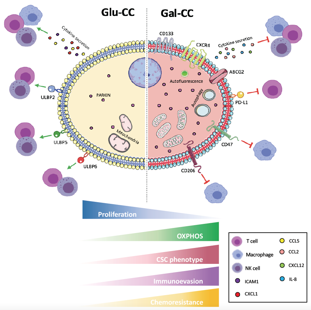Valle S, Alcalá S, Martin-Hijano L,... Sainz B Jr. Exploiting oxidative phosphorylation to promote the stem and immunoevasive properties of pancreatic cancer stem cells.
Nat Commun. 2020
"The secret is none other than changing the sugar source used by these cells. Instead of using glucose (a sugar source commonly used in cell cultures), we have observed that by using galactose, which promotes mitochondrial respiration, we can achieve a culture highly enriched in CSCs, and sustainable over months". - Dr. Bruno Sainz Anding –
Summary:
Pancreatic ductal adenocarcinoma (PDAC), the fourth leading cause of cancer death, has a 5-year survival rate of approximately 7-9%. The ineffectiveness of anti-PDAC therapies is believed to be due to the existence of a subpopulation of tumor cells known as cancer stem cells (CSCs), which are functionally plastic, and have exclusive tumorigenic, chemoresistant and metastatic capacities. Herein, we describe a 2D in vitro system for long-term enrichment of pancreatic CSCs that is amenable to biological and CSC-specific studies. By changing the carbon source from glucose to galactose in vitro, we force PDAC cells to utilize OXPHOS, resulting in enrichment of CSCs defined by increased CSC biomarker and pluripotency gene expression, greater tumorigenic potential, induced but reversible quiescence, increased OXPHOS activity, enhanced invasiveness, and upregulated immune evasion properties. This CSC enrichment method can facilitate the discovery of new CSC-specific hallmarks for future.
Why do you highligth this publication?
Until now, not only has isolating and culturing CSCs been challenging, but long-term cultures of these cells in amenable screening platforms (e.g. 2D monolayers) was essentially impossible. We have overcome this obstacle by developing an OXPHOS-driven CSC-enriched 2D system, which will help advance our understanding of pancreatic CSCs, specifically the mechanisms they use to resist treatments and the strategies they possess to evade the immune system and promote metastasis. This research should also open the door to the discovery of new therapies for the treatment of pancreatic cancer.
Publication commented by:
Dr. Bruno Sainz
Instituto de Investigaciones Biomédicas "Alberto Sols" CSIC-UAM
Autónoma University of Madrid (UAM), Department of Biochemistry
Cancer stem cells and fibroinflammatory microenvironment
IRYCIS



